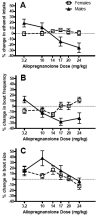Manipulation of GABAergic steroids: Sex differences in the effects on alcohol drinking- and withdrawal-related behaviors
- PMID: 19615369
- PMCID: PMC2813380
- DOI: 10.1016/j.yhbeh.2009.07.002
Manipulation of GABAergic steroids: Sex differences in the effects on alcohol drinking- and withdrawal-related behaviors
Abstract
Alcoholism is a complex disorder that represents an important contributor to health problems worldwide and that is difficult to encompass with a single preclinical model. Additionally, alcohol (ethanol) influences the function of many neurotransmitter systems, with the interaction at gamma-aminobutyric acid(A) (GABA(A)) receptors being integral for ethanol's reinforcing and several withdrawal-related effects. Given that some steroid derivatives exert rapid membrane actions as potent positive modulators of GABA(A) receptors and exhibit a similar pharmacological profile to that of ethanol, studies in the laboratory manipulated GABAergic steroid levels and determined the impact on ethanol's rewarding- and withdrawal-related effects. Manipulations focused on the progesterone metabolite allopregnanolone (ALLO), since it is the most potent endogenous GABAergic steroid identified. The underlying hypothesis is that fluctuations in GABAergic steroid levels (and the resultant change in GABAergic inhibitory tone) alter sensitivity to ethanol, leading to changes in the positive motivational or withdrawal-related effects of ethanol. This review describes results that emphasize sex differences in the effects of ALLO and the manipulation of its biosynthesis on alcohol reward-versus withdrawal-related behaviors, with females being less sensitive to the modulatory effects of ALLO on ethanol-drinking behaviors but more sensitive to some steroid manipulations on withdrawal-related behaviors. These findings imply the existence of sex differences in the sensitivity of GABA(A) receptors to GABAergic steroids within circuits relevant to alcohol reward versus withdrawal. Thus, sex differences in the modulation of GABAergic neurosteroids may be an important consideration in understanding and developing therapeutic interventions in alcoholics.
2009 Elsevier Inc. All rights reserved.
Figures






Similar articles
-
Replacement with GABAergic steroid precursors restores the acute ethanol withdrawal profile in adrenalectomy/gonadectomy mice.Neuroscience. 2010 Mar 10;166(1):5-14. doi: 10.1016/j.neuroscience.2009.11.075. Epub 2010 Jan 6. Neuroscience. 2010. PMID: 20004707 Free PMC article.
-
Inhibition of 5alpha-reduced steroid biosynthesis impedes acquisition of ethanol drinking in male C57BL/6J mice.Alcohol Clin Exp Res. 2008 Aug;32(8):1408-16. doi: 10.1111/j.1530-0277.2008.00718.x. Epub 2008 Jun 28. Alcohol Clin Exp Res. 2008. PMID: 18565155 Free PMC article.
-
Sex differences in the effect of ethanol injection and consumption on brain allopregnanolone levels in C57BL/6 mice.Neuroscience. 2004;123(4):813-9. doi: 10.1016/j.neuroscience.2003.11.017. Neuroscience. 2004. PMID: 14751275
-
The role of pregnane neurosteroids in ethanol withdrawal: behavioral genetic approaches.Pharmacol Ther. 2004 Feb;101(2):91-112. doi: 10.1016/j.pharmthera.2003.10.006. Pharmacol Ther. 2004. PMID: 14761701 Review.
-
Role of GABAA receptors in alcohol use disorders suggested by chronic intermittent ethanol (CIE) rodent model.Mol Brain. 2017 Sep 20;10(1):45. doi: 10.1186/s13041-017-0325-8. Mol Brain. 2017. PMID: 28931433 Free PMC article. Review.
Cited by
-
Microstructural analysis of rat ethanol and water drinking patterns using a modified operant self-administration model.Physiol Behav. 2015 Oct 1;149:119-30. doi: 10.1016/j.physbeh.2015.05.034. Epub 2015 May 31. Physiol Behav. 2015. PMID: 26037631 Free PMC article.
-
Chronic ethanol drinking increases during the luteal menstrual cycle phase in rhesus monkeys: implication of progesterone and related neurosteroids.Psychopharmacology (Berl). 2019 Jun;236(6):1817-1828. doi: 10.1007/s00213-019-5168-9. Epub 2019 Jan 15. Psychopharmacology (Berl). 2019. PMID: 30645681 Free PMC article.
-
Genotype Differences in Sensitivity to the Anticonvulsant Effect of the Synthetic Neurosteroid Ganaxolone during Chronic Ethanol Withdrawal.Neuroscience. 2019 Jan 15;397:127-137. doi: 10.1016/j.neuroscience.2018.11.045. Epub 2018 Dec 2. Neuroscience. 2019. PMID: 30513375 Free PMC article.
-
Missense Gamma-Aminobutyric Acid Receptor Polymorphisms Are Associated with Reaction Time, Motor Time, and Ethanol Effects in Vivo.Front Cell Neurosci. 2018 Jan 31;12:10. doi: 10.3389/fncel.2018.00010. eCollection 2018. Front Cell Neurosci. 2018. PMID: 29445327 Free PMC article.
-
Quantification of ten neuroactive steroids in plasma in Withdrawal Seizure-Prone and -Resistant mice during chronic ethanol withdrawal.Psychopharmacology (Berl). 2014 Sep;231(17):3401-14. doi: 10.1007/s00213-014-3618-y. Epub 2014 May 29. Psychopharmacology (Berl). 2014. PMID: 24871700 Free PMC article.
References
-
- Alele PE, Devaud LL. Sex differences in steroid modulation of ethanol withdrawal in male and female rats. J. Pharmacol. Exp. Ther. 2007;320:427–436. - PubMed
-
- Anton RF, Drobes DJ, Voronin K, Durazo-Avizu R, Moak D. Naltrexone effects on alcohol consumption in a clinical laboratory paradigm: temporal effects of drinking. Psychopharmacology. 2004;173:32–40. - PubMed
-
- Ballenger JC, Post RM. Kindling as a model for alcohol withdrawal syndromes. Br. J. Psychiatry. 1978;133:1–14. - PubMed
-
- Barbaccia ML, Affricano D, Trabucchi M, Purdy RH, Colombo G, Agabio R, Gessa GL. Ethanol markedly increases “GABAergic” neurosteroids in alcohol-preferring rats. Eur. J. Pharmacol. 1999;384:R1–R2. - PubMed
Publication types
MeSH terms
Substances
Grants and funding
LinkOut - more resources
Full Text Sources
Medical

